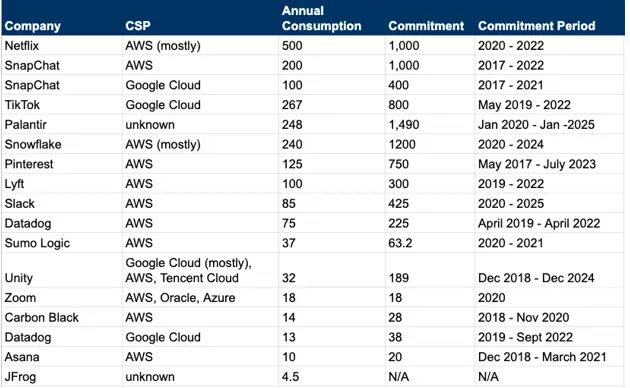As highlighted in the Visual Capitalist’s The Impressive Stats Behind Amazon’s Dominance of the Cloud, AWS has over one million active enterprise customers. AWS currently dominates the public cloud market; even more impressively, Netflix, an AWS partner, accounts for one third of all internet traffic during its peak usage times.
It should come to no one’s surprise that some of the world’s biggest consumer tech companies currently spend hundreds of millions of dollars a year on cloud computing services like Amazon Web Services (AWS), Google Cloud Platform (GCP), and Microsoft Azure.
So, who are the biggest cloud spenders?
In September 2020, cloud management firm Bepsin Global released a compilation of SaaS companies who spend the most on the public cloud and their annual cloud costs. Check them out below:
- Netflix
- SnapChat
- Tik Tok
- Palantir
- Snowflake
- Lyft
- Slack
- Datadog
- Sumo Logic
- Unity
- Zoom
- Carbon Black
- Asana
- JFrog

Keep in mind that the figures isolated in the graph above are only estimated annual cloud costs. Actual costs are expected to be higher.
What are some contributing factors to high cloud costs?
For the SaaS companies highlighted in this blog post, the cloud categories in which they spend will vary — whether that be hosting, CDN, security, and others.
The majority, it seems, spend the most on virtual machines. For example, as a large streaming platform giant, Netflix’s highest cloud costs go toward Amazon Elastic Compute Cloud (Amazon EC2). They spend upwards of $3 million a month on Amazon EC2 whilst spending much less on AWS Elastic Load Balancer, Amazon CloudFront, and other AWS products.
Ultimately, however, the main reason why these SaaS companies spend millions on the public cloud is because of contractual periods.

Unlike typical consumers of AWS, these big corporations are opting for multi-year contracts with cloud providers.
In 2017, for example, Pinterest, an image sharing platform, negotiated a deal with Amazon, promising to spend $750 million USD on AWS by 2023. In exchange for securing multi-year contracts, tech companies can benefit from reduced cloud cost structures and pricing discounts.
In the same year, Snapchat pledged to spend $2 billion USD on AWS throughout a 5 year period. Tik Tok signed a similar deal with AWS in May 2019 and agreed to pay at least $800 million USD over three years.
While pricing discounts and predictable cloud cost budgeting are the main benefits of locking in a multiyear contract, it’s also important to keep in mind that these companies are still largely paying for what they use.
What this means for other businesses
As the COVID-19 pandemic continues, the cloud usage of SaaS companies is exploding with growth. Yet, for many, the cloud only makes up small portions of even larger IT budgets.
The cloud is not cheap, which affects the way businesses and organizations make decisions on their cloud expenditures by making them take a more proactive approach in optimizing their cloud costs.
Because not every business or organization secures a multi-year “commitment” contract with the biggest cloud providers, there are plenty of cost saving opportunities for these businesses to explore.
Learn more at cloud cost optimization at gruamtic.com.





